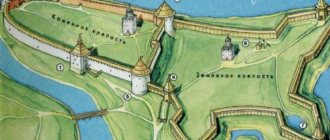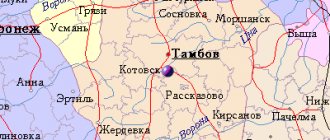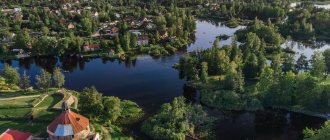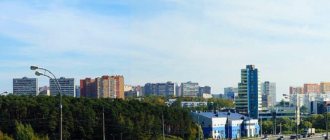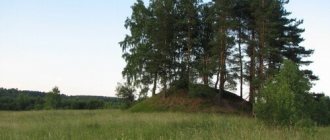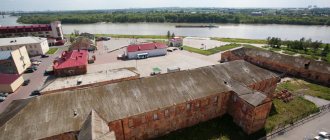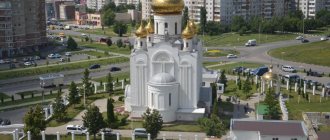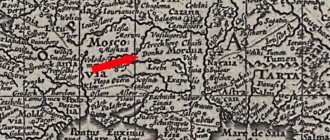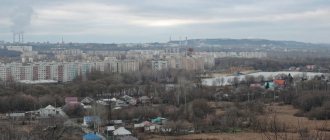City in Bryansk region, Russia
| Mglin Mglin | |
| Town[1] | |
| Coat of arms | |
| Location of Mglin | |
| Mglin Location of Mglin Show map of Russia Mglin Mglin (Bryansk region) Show map of Bryansk region | |
| Coordinates: 53°03′N 32°51'E / 53.050°N W. 32.850°E / 53.050; 32.850Coordinates: 53°03′N 32°51'E / 53.050°N W. 32.850°E / 53.050; 32.850 | |
| A country | Russia |
| Federal subject | Bryansk region[1] |
| Administrative region | Mglinsky district[2] |
| City administrative district | Mglinsky[2] |
| First mention | 1389 |
| City status from | 1781 |
| Height | 180 m (590 ft) |
| population (2010 Census)[3] | |
| • General | 7,916 |
| • Evaluate (2018)[4] | 7,578 (-4.3%) |
| Administrative status | |
| • Capital from | Mglinsky district[1], Mglinsky city administrative district[2] |
| Municipal status | |
| • Municipal district | Mglinsky municipal district[5] |
| • Urban village | Mglinskoe village[5] |
| • Capital from | Mglinsky municipal district[5], Mglinskoye urban-type settlement[5] |
| Timezone | UTC + 3 (MSK [6]) |
| Postal code(s)[7] | 243220 |
| Dial code(s) | +7 48339 |
| OKTMO I WOULD | 15636101001 |
Mglin
(Russian: Mglin, Polish: Mglin) is a town and the administrative center of Mglinsky District in Bryansk Oblast, Russia, located on the Sudinka River 167 km (104 mi) west of Bryansk, the administrative center of the region. Population: 7,916 (2010 Census);[3]8,261 (2002 Census);[8]7,704 (1989 Census).[9]
Story
Historical affiliation
Grand Duchy of Lithuania ca. 1389–1502 Grand Duchy of Moscow 1502–1547 Kingdom of Russia 1547–1607 Polish-Lithuanian Commonwealth 1607–1667 Kingdom of Russia 1667–1721 Russian Empire 1721–1917 Russian Republic 1917 Soviet Russia 1917–1922 Soviet Union 1922–1991 Russian Federation 1991–present
Mglin was first mentioned in 1389, although the settlement on which it was built had existed since the 12th century.[ citation needed
]
During World War II, Mglin was occupied by the German army from August 16, 1941 to September 22, 1943. Before the war, 726 Jews lived in the city. Most Jews were merchants and artisans. There was also a Jewish collective farm. There was a synagogue in the city, but it was closed before the war. Some Jews managed to evacuate before the Germans arrived. Soon after the occupation, all Jews were registered and marked. In January 1942 they were placed in prison, where they remained until their execution on March 2, 1942. While in prison, Jews were used for forced labor. Before execution, Jews had to strip down to their underwear in a small house, which was a morgue, located about 500 meters from the mass grave. The shooting was carried out by a special German punitive unit in black uniforms, as a result of which about 500 people were killed.[10]
An ancient manor in Novaya Romanovka
But the most striking impression of the trip was a visit to the ancient and poorly preserved Dunin-Borkovsky estate, located in the village of Novaya RomanOvka.
The village itself was founded in 1694 by centurion Ivan Romanovsky, hence the emphasis - not RomAnovka, as we thought when we read the name on the sign, but RomanOvka! Like many old estates, the estate passed from hand to hand, experiencing periods of ups and downs.
Artist V.L. Borovikovsky
Some important events in this estate and its surroundings are associated with the life and work of the famous Russian artist Vladimir Lukich Borovikovsky (1757–1825), one of the first portrait painters in Russia.
The artist was born in Mirgorod. His father, Luka Borovik, belonged to the local Cossack elders, owned a house and two small plots of land. Following tradition, four of his sons served in the Mirgorod regiment, but Vladimir retired with the rank of lieutenant and devoted himself to painting.
The father, who painted icons for rural churches, taught icon painting to his children, and the Borovikov dynasty became famous in the local art association. The Kiev Museum of Ukrainian Art and the Russian Museum contain icons painted by the young painter.
A happy accident allowed Vladimir to distinguish himself in front of the empress. He painted two allegorical paintings for one of the “travel palaces”, which Catherine II liked, and she invited the artist to St. Petersburg to study at the Academy of Arts. His mentor and teacher was first the Russian portrait artist D.G. Levitsky, and then the Austrian painter who worked at the court, I.D. Lampi.
Borovikovsky quickly became a popular and fashionable portrait painter, his paintings are kept in the largest art galleries in Russia and Ukraine, in them we can see the faces of his famous contemporaries - Empress Catherine II, Emperor Paul I, their courtiers, noble people of that time.
Particularly lyrical and memorable were his portraits of women and children - Maria Lopukhina, the Gagarin sisters, etc. In his portraits, the artist almost always found a place for the Little Russian landscape that was dear to his heart. A deeply religious man, Borovikovsky also painted icons.
Church of the Intercession
At the beginning of the 19th century, the famous artist painted an iconostasis with 26 icons for the stone Church of the Intercession under construction, all of them were done in oil on large wooden boards.
To this day, five icons by Borovikovsky from the Church of the Intercession in Novaya Romanovka have survived - “The Savior”, “The Virgin and Child”, “Archangel Michael” are in the State Tretyakov Gallery, another one - “Archangel Gabriel” - in Alma-Ata, in the State Kazakh Gallery, and the icon “Queen Alexandra and Archdeacon Stefan” is in the Bryansk Regional Art Museum (data from the “Code ...”).
It is not clear whether Vladimir Lukich himself visited Novaya Romanovka, I did not find exact information, and on the unpreserved main icon of the Church of the Intercession, as sources testify, there was an inscription: “In this temple, icons were painted by the Imperial Academy of Arts by adviser Vladimir Lukich Borovikovsky in S.P. "Burg 1815"
The Church of the Intercession itself had a very interesting architectural design. Built in the style of late classicism, it had a cruciform composition, which gave it simplicity and harmony. Plastered inside and out, with noble proportions, the church was visible from afar.
But, like many other religious buildings, the church, although, fortunately, was not destroyed, remained desolate for many decades. Only recently did local residents take up the task of restoring it. The old walls still demonstrate an enviable fortress, so that, in time, it will delight our contemporaries, as it once pleased their ancestors. But the iconostasis by Borovikovsky will no longer be there...
Main house
The ruins of the beautiful old Dunin-Borkowski estate are now suitable only for filming a horror film about vampires. But until relatively recently, it was almost completely intact, having avoided destruction and becoming a rural school for quite a long time, as evidenced by the remains of panels preserved on the walls. Probably, after the construction of a new school in the early 70s, this old estate began to truly collapse and is now a sad sight!
One can only guess what rooms were there before! But there was a ballroom, and state living rooms, and bedrooms, and offices. All this was filled with beautiful furniture, decorated with paintings, possibly works of famous artists, and simply filled with the life of the family, its guests and the spirit of the times!
Recommendations
Notes
- ^ a b c d
Law No. 13-Z - ^ a b c d
Law No. 69-Z - ^ a b
Federal State Statistics Service of Russia (2011).
“All-Russian Population Census 2010. Volume 1" [All-Russian Population Census 2010, vol. 1]. All-Russian Population Census 2010 [All-Russian Population Census 2010]
(in Russian). Federal State Statistics Service. - "26. The size of the permanent population of the Russian Federation by municipalities as of January 1, 2022.” Federal State Statistics Service. Retrieved January 23, 2022.
- ^ a b c d f
Law No. 3-Z - "On the calculation of time." Official Internet portal of legal information
(in Russian). June 3, 2011. Retrieved January 19, 2022. - Post office. Information and computing center of OASU RPO. ( Post office
).
Search for postal facilities ( Search for postal facilities
) (in Russian) - Federal State Statistics Service of Russia (May 21, 2004). “The population of Russia, the constituent entities of the Russian Federation as part of federal districts, urban settlements, urban settlements, settlements, settlements is 3 thousand or more people” [Population of Russia, its federal districts, constituent entities of the federation, districts, urban settlements, rural settlements - administrative centers, rural settlements with a population of more than 3000 people] (XLS). All-Russian Population Census of 2002 [All-Russian Population Census of 2002]
(in Russian). - “All-Union Population Census of 1989. The actual population of the union and autonomous republics, autonomous regions and districts, territories, regions, urban settlements and villages-raiBryansk worker”, No. 119, June 24, 1997 (Bryansk Regional Duma. Law No. 13- Z dated June 5, 1997 On the administrative-territorial structure of the Bryansk region
As amended by Law No. 4-Z dated 02/05/2014
On amendments to various legislative acts of the Bryansk region
. - Bryansk Regional Duma. Law No. 69-Z of November 2, 2012 “On the formation of city administrative districts, settlement administrative districts, city administrative districts, establishment of boundaries, names and administrative centers of administrative districts in the Bryansk region.” Entered into force on January 1, 2013. Published: Newsletter “Official Bryansk Region”, No. 16, November 6, 2012. (Bryansk Regional Duma. Law No. 69-Z of November 2, 2002. On the formation of city administrative districts, village administrative districts, rural administrative districts, on establishing the boundaries, names and administrative centers of administrative districts of the Bryansk region
... Valid from January 1, 2013). - Bryansk Regional Duma. Law No. 3-Z of March 9, 2005 “On granting municipalities the status of a city district, municipal district, urban settlement, rural settlement and establishing the boundaries of municipalities in the Bryansk region,” as amended. Law No. 75-Z of September 28, 2015 “On changing the settlement of Krasny Yatvizh, Kletnyansky district, Bryansk region.” Came into force 10 days after official publication. Published: “Bryansk Week”, No. 13, April 8, 2005 (Bryansk Regional Duma. Law No. 3-Z of March 9, 2005 On assigning to municipalities the status of a city district, municipal district, urban settlement, rural settlement and on the establishment boundaries of municipalities of the Bryansk region
As amended by Law No. 75-Z dated September 28, 2015.
On changing the status of the settlement of Krasny Yatvizh, Kletnyansky district, Bryansk region
. Valid from the day that is 10 days after official publication.).
External links [edit]
- Murder of the Jews of Mglin during World War II, on the Yad Vashem website.
| vteAdministrative divisions in the Bryansk region | ||
| Administrative center: Bryansk • Village. | ||
| Districts |
| |
| Cities and towns |
| |
| Urban settlements |
| |
Historical and memorable places of the Bryansk region
One of the oldest cities of the Bryansk land - Mglin - is located on the steep bank of the Sudynka River, a tributary of the Iput. The name of the city is associated by some researchers with the once gloomy, misty forests that surrounded it; others believe that the name came from the water mills that once surrounded the city (in Ukrainian “mlyn” means mill). Once upon a time, back in the 12th century. on this site was the city of Zarty (Zaryty), completely destroyed by the Tatars. Mglin began to be mentioned in the list of Russian cities around 1389, in connection with its capture by Lithuania and in 1501 after the expulsion of the Lithuanians. Over the course of a century, it was repeatedly raided from the west, until at the beginning of the 17th century it was recaptured, this time by the Poles.
Only in 1654 did Mglin finally pass to the Russian state. But it still remains a stronghold for the defense of the western borders. In 1663, Tatars and Poles came here, in 1708 - Swedes.
For some reason, the small town was liked by influential people. For several years, Peter I’s favorite A.D. Menshikov considered it “his principality.” In 1760, Elizaveta Petrovna granted the city to Count K.G. Razumovsky.
In 1781, Mglin became a district town (it then had 2,000 inhabitants) of the Novgorod-Seversky governorship, and from 1802 - the Chernigov province. For a long time it remained a small administrative and trading town. In memory of “..the deliverance of Mglin from enemy invasion and devastation...” the townspeople built the Cathedral of the Assumption of Our Lady (1830).
By 1861, its population had quadrupled. Three brick factories, two tallow factories and a tannery appeared here. They were very small and their products, which did not exceed the cost of 10 thousand rubles, were sold locally. However, they did not last long: at the beginning of the 20th century. they were no longer there, but two oil mills appeared, producing 19 thousand pounds of hemp oil. Trade in hemp, oil, and livestock fell into decline. The decline in the city’s business activity is explained by the competition of Pochep, which received the opportunity for development with the construction of the Bryansk-Gomel railway. The city with a population of 11 thousand remained aloof from communication routes. Only local crafts flourished in Mglin. A rapid outflow of the population began.
After the October Revolution, an attempt was made to stop the decline. Several enterprises for processing agricultural products from the area and a sawmill were built in the city. After the Great Patriotic War, a starch and syrup factory, a butter factory, a brick factory, a clothing factory, and an industrial plant were re-established. The city has so far stabilized in population at around 8.3 thousand people. There are public services needed by the urban population, healthcare, educational and cultural institutions. Potato growing predominates in the region's agriculture. Of the industrial crops, the greatest attention is paid to hemp, fiber flax and cigar tobacco. Livestock farming has a dairy and meat direction.
The modern city has its own coat of arms: “In the upper scarlet field of the crossed shield there is a golden mortar, accompanied on the sides by a pyramid of cannonballs. In the lower green field there is an azure circle with a gold stylized flask, framed by gold stylized fragments of a circular saw, gear and ear...” In the development of the historical city (the city of Mglin is one of the 115 ancient Russian cities of Russia), architectural monuments have been preserved, forming a special, unique atmosphere, about which A.K. Tolstoy, a resident of Mglinsky district, once wrote: “There is only one city, it’s called Mglin...”.
- Babushkin A.N. Bryansk region: Geographer. and ist.-econ. feature article. — Bryansk: Bryan. worker, 1958. - P. 341-343.
- Bryansk region: guide to places of interest / ed. I.V. Polyakova; cons. EAT. Zubova, V.P. Alekseev, S.A. Nikulina, K.V. Sychev. - Bryansk, 2006. - pp. 25-26.
- Coats of arms of Russian cities: Album - reference / Soboleva N.A. and others - M.: Profizdat-"Fatherland", 1998. - P. 178 p.
- Gorodkov, V.N. Architectural image of Mglin / V.N. Gorodkov // Estates of the Bryansk region: from the history of the cultural heritage of the Bryansk region: in 2 volumes. T. I. - 2022. - T. 1. - P. 141-145
- Kizimova S.P. Mglin: Historical-Econ. feature article. — Bryansk: Bryan. worker, 1964. - 46 p.: ill.
- Lazarevsky A. Description of old Little Russia: Materials for the history of settlement, land ownership and management. T. 1. Regiment Starodubsky. — Kyiv: Type .K.N. Milevsky, 1888.- pp. 324-360
- Materials for the assessment of real estate in Chernigov. Provinces. Part 1. Cities. Vol. XVI. Mglin / Ed. Chernigov. Governor. Earth Boards. — Chernigov: Type. Governor. Zemstvo, 1913.- 28 p. The book also contains: Appendixes: Mr. Mglin. — 32 s.
- Mglin // Cities of Russia: Encycl. - M., 1994. - P. 255.
- Mglin // Small encyclopedic dictionary. - Reprint. reproduction ed. F. Brockhaus - I.A. Efron. - M., 1994. - T. 3. - P. 518.
- Mglin // Pages from the Bryansk Chronicle: Special. issue "Agitator's Notebook" - Bryansk, 1968. - P. 157-161.
- Mglin //Encyclopedic Dictionary. - Reprint. reproduction ed. F. Brockhaus-I.A. Efron 1890 - M., 1991. - T. 36. - P. 845-846.
- Protchenko Z.E. Mglinskaya land is my native land. - Bryansk: Kladez, 1993. - 225 p.
- Tsapenko M. Bryansk land. - M.: Art, 1972. - P. 47-50.
- Atamanenko M. Mglin in the history of Russia // Mglin. lead. - 2001. - July 18.
- Galagan S. Poetry of the urban landscape // Mglin. lead. — 1997. — September 12.
- Gamkova L. How old, how many winters are you, Mglin?: [610th anniversary of the city of Mglin] // Bryan. news. — 1997. — Oct. 15.
- Kozlov D. Breath of Antiquity // Mglin. lead. - 1997. - September 17.
- Sokolov Y. Mglin//Bryan. worker. - 1998. - January 30. — P. 17.
